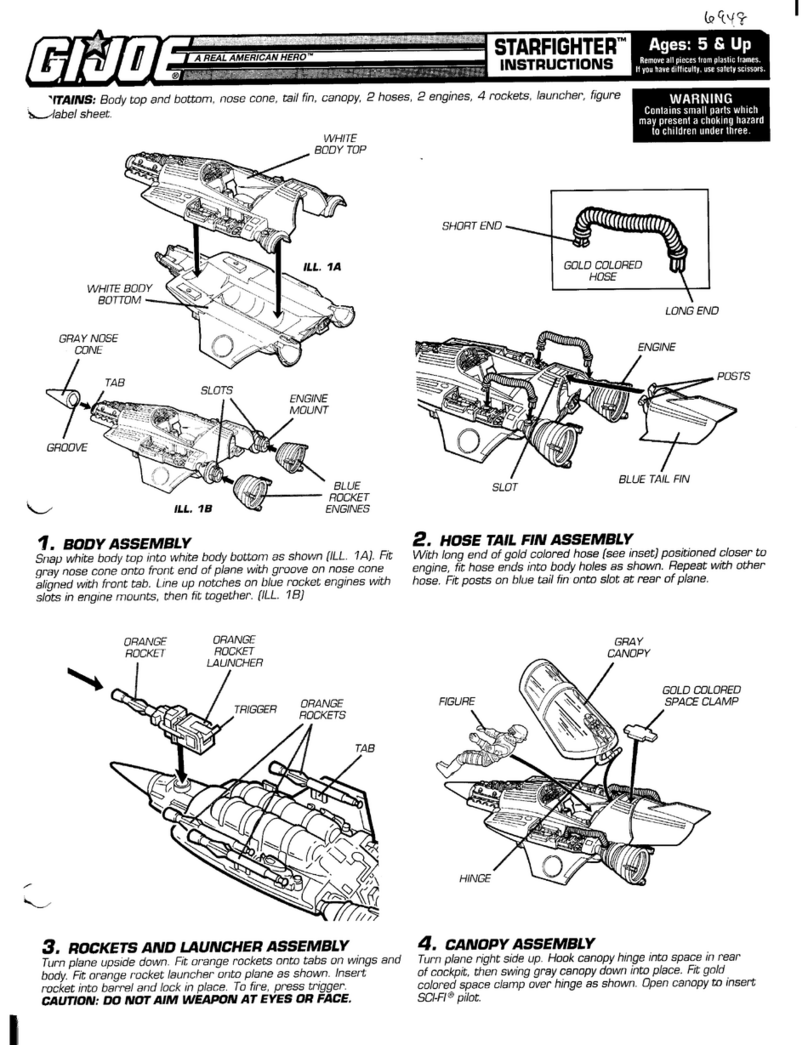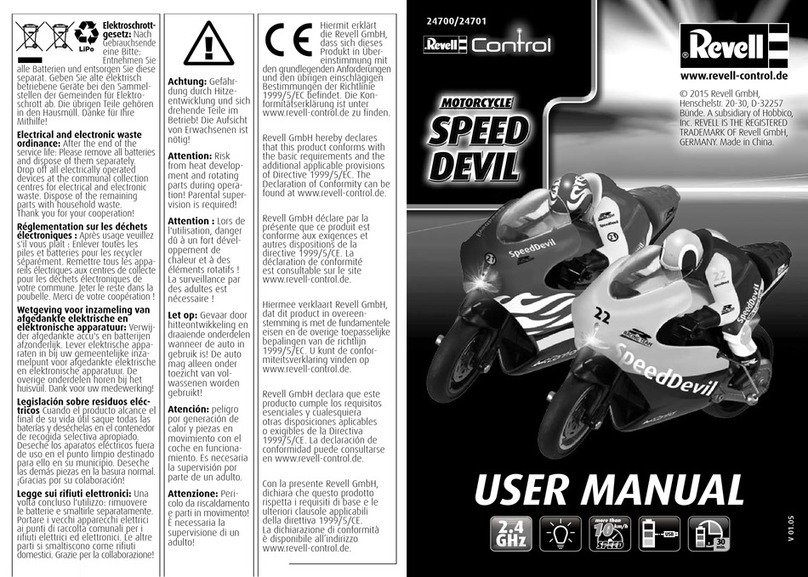Global Specialties PB-503A User manual

User Manual
PB-503A
Desktop Circuit Design Trainer

2
globalspecialties.com
Global Specialties
Symbols and Terms ......................................... . . . . . . . .3
Denitions ................................................ . . . . . . . .3
General Safety Information ................................... . . . .4, 5, 6
Compliance and Certications................................. . . . . . . . .7
Introduction ............................................... . . . . . . . .7
Features and Applications .................................... . . . . . . . .8
Courseware ............................................... . . . . . . . .9
Frontal Panel Description . . .................................. . . . . . . .10
Components and Features. . . . . . . . . . . . . . . . . . . . . . . . . . . . . . . . . . . . . . . .11, 12
Specications ............................................. . . . .13, 14
Checking out the PB-503A ................................... . . . .15, 16
Breadboarding Techniques ................................... . . . . . . .17
Warranty and Service Information .............................. . . . . . . .18
© 2022 Global Specialties. All rights reserved.
Unauthorized duplication of Global Specialties documentation materials is strictly prohibited.
Customers are permitted to duplicate and distribute Global Specialties documentation for
internal educational purposes only.
Table of Contents

globalspecialties.com
Global Specialties
3
451-032-001_rA
Caution Symbol (ISO 7000-0434) - Statements or instructions that must be
consulted in order to nd out the nature of the potential hazard and any actions
which must be taken.
A statement calling attention to an operating procedure, practice, or condition,
which if not followed correctly, could result in damage to or destruction of parts
or the entire product.
A statement calling attention to an operation procedure, practice, or condition,
which if not followed correctly, could result in injury or death to personnel.
Power on. This is the AC mains connect/disconnect switch on the trainer.
Power o. This is the AC mains connect/disconnect switch on the trainer.
This symbol is used to denote an AC signal
This symbol is used to denote the chassis ground
This symbol is used to denote the earth ground
Symbols and Terms
Definitions
POLLUTION (P)
Addition of foreign matter solid, liquid or gaseous (ionized gases), that may product a reduction
of dielectric strength or surface resistivity.
Degree 2 (P2) - Only non-conductive pollution occurs except that occasionally a temporary
conductivity caused by condensation is expected.
MEASUREMENT CATEGORY (CAT)
Classication of testing and measuring circuit according to the type of mains circuits to which
they are intended to be connected.
CAT II - measuring circuits connected to utilization points of the low-voltage mains installation.
CAUTION
WARNING

4
globalspecialties.com
Global Specialties
Hands, shoes, oor, and work bench must be dry. Avoid making
measurements with dampness, or other environmental conditions that might
aect safety.
General Safety Information
To avoid personal injury and/or product damage, review and comply with the following safety
precautions. These precautions apply to both operating and maintenance personnel and must
be followed during all phases of operation, service, and repair o this meter. Before applying
power be sure to:
• Read and understand the safety and operational information in this manual.
• Apply all the listed safety precautions.
• Verify that the voltage selector on the back of the unit is set to the correct line voltage.
Operating the instrument at an incorrect line voltage will void the warranty.
• Make all connections before applying power.
• Do not operate the instrument in ways not specied by this manual or by Global
Specialties.
Failure to comply with these precautions or with warnings elsewhere in this manual violates
the safety standards of design, manufacture, and intended use of the instrument. Global
Specialties assumes no liability for a customer’s failure to comply with these requirements.
Dry Conditions
Use a soft cotton cloth lightly moistened with a mild solution of detergent and
water. Do not allow any portion to be submerged at any time. Dry thoroughly
before attempting to make measurements. Do not use solvents or expose to
solvent fumes as they may cause deterioration or damage.
Cleaning
Do not Operate
• In the presence of noxious, corrosive, ammable fumes, gases, vapors, chemicals, or
nely-divided particulates.
• In environments where there is a danger of any liquid being spilled on the meter.
• In air temperatures exceeding the specied operating temperatures.
• In atmospheric pressures outside the specied altitude limits or where the
surrounding gas is not air.
Only for use in pollution degree 2 environments where non-conductive pollution occurs except
occasionally when a temporary conductivity caused by condensation is expected.
CAUTION
WARNING

globalspecialties.com
Global Specialties
5
451-032-001_rA
Electrical Power
This instrument is intended to be powered from a CATEGORY II mains
power environment. The mains power should be 115 VAC or 230 VAC
(±10%) at 50/60 Hz. Use only the power cord supplied with the instrument
and ensure it is appropriate for your country of use. Slide the switch on the
back of the trainer to select the appropriate input making sure the correct
fuse is installed. This trainer consumes less than 50 W.
Fuse Replacement
Indoor Use
Ground the Instrument
To minimize shock hazard, the instrument case must be connected to an
electrical safety ground. This instrument, and the chassis, is grounded
through the ground conductor of the supplied, three-conductor AC power
cable per IEC 60320-1. Do not alter or bypass the ground connection.
Failure to use a properly-grounded approved outlet and the recommended
three-conductor AC line power cable may result in injury or death. Unless
otherwise stated, a ground connection on the instrument’s front is for a
reference of potential only and is not to be used as a safety ground.
This instrument is intended to be used in an indoor pollution degree 2 environment. The
operating temperature range is 0 °C to 40 °C and the operating humidity range is up to
80% relative humidity with no condensation allowed. Measurement results may be outside
specications if the instrument is used in non-oce-type environments. Such environments
may include rapid temperature or humidity changes, sunlight, vibration and/or mechanical
shocks, acoustic noise, electrical noise, strong electric elds, or strong magnetic elds.
Set the power switch to the OFF or O position and disconnect the power
cord before inspecting or replacing the fuse. Open the black fuse holder
(located at the back of the trainer below the input power receptacle) with
a small, at-head screwdriver. Remove the old fuse, replace it with a new
one, and reinstall the fuse holder. Use only 5 x 20 mm type T 1.5/250 V or
0.75A/250 V Fuses.
CAUTION
CAUTION
WARNING

6
globalspecialties.com
Global Specialties
Do not Operate
If the instrument is damaged, appears to be damaged, or if any liquid, chemical, or other
material gets on or inside the instrument, remove the instrument’s power cord, remove the
instrument from service, label it as not to be operated, and return the instrument to Global
Specialties for repair. Notify Global Specialties of the nature of any contamination of the
instrument.
Not for Critical Applications
This instrument is not authorized for use in contact with the human body or for use as a
component in a life-support device or system.
Instrument covers must not be removed by operating personnel. Component
replacement and internal adjustments must be made by qualied service
trained maintenance personnel who are aware of the hazards involved when
the instrument’s covers and shields are removed. Under certain conditions,
even with the power cord removed, dangerous voltages may exist when
the covers are removed. To avoid injuries, always disconnect the power
cord from the instrument, remove all other connections (for example, test
leads, probes, etc.), discharge all circuits, and verify there are no hazardous
voltages present on any conductors by measurements with a properly
operating voltage-sensing device before touching any internal parts. Verify
the voltage-sensing device is working properly before and after making the
measurements by testing with known operating voltage sources and test
voltages. Do not attempt any service or adjustment unless another person
capable of rendering rst aid and resuscitation is present. Hazardous
voltages may be present in unexpected locations in circuitry being tested
when a fault condition in the circuit exists.
Use Correctly Sized Wires
Do not Touch Live Circuit
Use only standard 4 mm banana plugs when connecting to power supplies.
Solid core wires no larger than 20 AWG must be used for connections to the
solderless breadboards.
WARNING
CAUTION
Do not Attempt Servicing

globalspecialties.com
Global Specialties
7
451-032-001_rA
Compliance and Certifications
This product meets the essential requirements of the applicable European Directives as
follows:
CE Compliance
This product is subject to Directive 2012/19/EU of the European Parliament
and the Council of the European Union on waste electrical and electronic
equipment (WEEE), and in jurisdictions adopting that Directive, is marked as
being put on the market after August 13, 2005, and should not be disposed
of as unsorted municipal waste. Please utilize your local WEEE collection
facilities in the disposition of this product.
*Applicable in the European Union and other European countries with separate collection
systems.
• 2014/30/EU: Electromagnetic Directive (EMC)
• 2014/35/EU: Low Voltage Directive (LVD)
• Standard IEC 61010-12011/65/EU + AMD2015/863: Reduction of
Hazardous Substances Directive (RoHS 2) ANNEX III Exemption 6(c)
The PB-503A Circuit Design Trainer is a versatile, time-saving tool for circuit designers,
engineering technicians, students, and hobbyists. A large breadboard area and a wide choice
of built-in circuit accessories allow rapid and accurate construction of virtually any type of
analog or digital circuit.
Circuit power is provided by three power supplies, two variable and one xed. The circuit
breadboard area includes over 2500 contact points. A multiple-waveform digital function
generator supplies sine, triangle, and square wave output for analog circuits. A built-in speaker
may be used for analog output.
Outputs also include a TTL-level square wave generator, two debounced pushbutton switches,
and a bank of eight logic switches. Eight logic indicators may be used to display high and low
logic levels. Two built-in potentiometers and two SPDT switches are provided for circuit control
and adjustment. Connections to external test equipment or signal sources may be made using
the two BNC connectors on the front panel.
Introduction
Disposal*

8
globalspecialties.com
Global Specialties
Features and Applications
The PB-503A eliminates the clutter and confusion that often results when constructing
sophisticated circuits. Alligator clips and similar connectors are seldom needed. Solderless
breadboards on the PB-503A allow insertion of components or wires of up to 20 gauge.
A detailed panel layout and description of the PB-503A is given in the section “Description of
Individual Features”.
The PB-503A Circuit Design Trainer is a robust electronics trainer suitable for all levels
of electronics instruction and design. Utilizing the PB-503A, students will learn valuable
hands-on breadboarding techniques and build a solid foundation in circuit experimentation,
c o n s t r u c t i o n a n d a n a l y s i s . E x p e r i e n c e d d e s i g n e r s w i l l n d t h e P B - 5 0 3 A a n i n v a l u a b l e
instrument, providing a reliable platform for the most advanced and demanding design
applications. The PB-503A can be used to construct basic series and parallel circuits to the
most complicated multi-stage microcomputer circuits, incorporating the latest in industrial
technology. Use the PB-503A to construct a wide variety of experiments, including but not
limited to:
• Opto-Device Circuits
• Clocks
• Multivibrators
• Oscillator Circuits
• Timers
• Function Generator Circuits
• Logic Circuits
• Gates
• Counters
• Flip-Flops
• Analog-to-Digital Converters
• Digital-to-Analog Converters
• Medium Scale Integration Circuits
• Phase Lock Loops
• Operational Ampliers

globalspecialties.com
Global Specialties
9
451-032-001_rA
Courseware
Courseware is available separately through our website or as part of the PB-503ALAB
package. The PB-503ALAB package oers comprehensive course instruction covering the
following areas:
Electronic Fundamentals Digital Electronics
Fundamentals of Electricity Number Systems & Codes
Ohm’s Law Binary, Decimal, Hexadecimal, Octal & ASCII
Series Circuits Logic Gates & Boolean Algebra
Parallel Circuits Combinational Logic Circuits
Combinational Circuits Flip-Flops
Current Control Digital Arithmetic
Closed, open, shorts Counters & Registers
Switches Integrated Circuit Logic Families
Thevenin’s Theorem TTL Logic
Wheatstone Bridge MOSFETS
Capacitors CMOS
Inductors Interfacing CMOS & TTL
Phase Shift Circuits Medium Scale Integration
Impedance Decoders
Resonant Circuits Encoders
Transformers Data Conversion & Acquisition
Rectiers & Filtering Microcomputer Concepts
Integrated Circuits
Transistor Ampliers
Oscillators
Power Control Circuits

10
globalspecialties.com
Global Specialties
Frontal Panel Description
In order to properly use the full capabilities of the PB-503A, it is highly recommended that the
user become familiar with the panel layout and the features of the components. See Figure 1.
A detailed panel layout and description of the PB-503A is given in the section “Components
and Features”.
The PB-503A can run o of 115 or 230 VAC. The unit comes standard with a 250 V / 1.5 A
type T fuse for the 115 VAC setting. In order to use with 230 VAC, please slide the switch in the
back to 230 VAC, and replace the fuse with a 250 V / 0.75 A type T fuse.
AC Line Input
Figure 1 - PB-503A - Front Panel Description
Ground
Binding
Posts
Logic
Indicators
AC Power Supply
Adjustment Variable
Positive / Negative
DC Power Supply
Binding Posts
Fixed Bus Strip,
connected to DC
Power Supplies
Power
Switch
Function
Generator
Debounced
Push Bottons
BNC
Connector
Speaker
Solderless
Breadboard
(2250 tie-points)
Model PB-3
BNC
Connector
SPDT Switches10k 1k
Potentiometers
Logic Switches

globalspecialties.com
Global Specialties
11
451-032-001_rA
By combining the three DC power supplies on the PB-503A, the user may work with virtually
any type of integrated circuit or discrete component. The xed 5 V / 1A supply has become
an industry standard for powering digital IC’s. Integrated circuits which require +5 V, +12 V,
and -5 V are easily accommodated by the PB-503A. The variable supply output voltages may
be changed by adjusting the knobs at the top on the front panel. The positive and negative
outputs are variable from +1.3 at 150 mA to +15 V 500 mA and -1.3 at 150 mA to -15 V at 500
mA. Both variable supply outputs are referenced to circuit common. This creates a split supply
which is often used with dierential and operational ampliers (op amps).
Components and Features
Sixteen LEDs, eight red and eight green, make up eight Logic Indicators that will display logic
high and low conditions based on either TTL or CMOS thresholds, selectable by the user.
Operating voltage can also be selected by the user to be either at +5 V, or +1.3 V to 15 V
at the setting of the +V supply. This selection should be the same as the operating circuitry
that is to be monitored. The red LEDs will light when the voltages at the inputs are 2.2 V or
higher when in the TTL position, or 70% of the operating voltage or higher when in the CMOS
position. The green LEDs will light when the voltages at the inputs are 0.8 V or less when
in the TTL position, or 30% of the operating voltage or less when in the CMOS position. An
unconnected input, or an input not at a valid logic level, will cause both LEDs to be o. Note
that the thresholds determined by the TTL positions are only accurate when the +5 volt range
is selected. The 100 kΩ input impedance ensures minimal loading eects of the circuit under
test.
Power Supplies
Digital Function Generator
Logic Indicators
The multi-waveform digital function generator provides continuously variable frequency
signals from 0.1 Hz (for extra-low frequency work) to radio frequency signals of 100 kHz. The
frequency is selected in two ranges, with a LED screen to easily view the current settings. The
generator can be set in increments of 0.1 Hz or 0.1 kHz in their respective ranges as desired.
The sine wave output is factory adjusted for minimum distortion. The triangle waveform is
adjusted for best linearity. The standard square wave and TTL level outputs are both set at a
50% duty cycle. The low output impedance of the sine, square, and triangle waveforms (600
Ω) assures maximum coupling of the output signal to the device being driven. All outputs can
withstand a continuous short circuit to ground. The signal amplitude can be adjusted from 0 to
20 Vpp with an open circuit and 0 to 10 Vpp with a 600 Ω load.

12
globalspecialties.com
Global Specialties
The PB-503A uses clocked ip-ops to provide debounced pushbutton switch functions. The
pushbutton circuitry has open-collector outputs which can sink up to 250 mA each. This type of
debouncing gives the user a sharp, glitch-free trigger source which assures reliable operation
in digital circuits. Each pushbutton has a normally-open and a normally-closed output. If
necessary, a pull-up resistor can connect any pulser output to any of the positive voltage
sources.
Components and Features
Debounced Pushbuttons (Pulsers)
Potentiometers
Two potentiometers are provided on the trainer. The resistance values chosen (1 kΩ and 10
kΩ) may be used in common circuit applications such as volume controls, DC oset controls
for op amps, and timing circuit controls. All leads for both potentiometers are available and
uncommitted.
BNC Connectors
The PB-503A may be connected to other pieces of equipment via two BNC connectors. This
allows the use of shielded cable to minimize noise and interference.
Switches
Two single pole, double throw (SPDT) switches are provided for general switching functions.
All leads are available and clearly marked on the PB-503A for easy connection. Eight
switches are congured as Logic Switches to provide a convenient source of digital outputs.
These switches will provide logic levels of zero V (ground) for a logic low, and logic high
levels of either +5 V or +1.3 to +15 V at the voltage setting of the +V supply. The high level is
determined by the setting of the +5/+V switch. This arrangement makes connecting special
digital circuitry such as an eight-bit input port quick and easy, and allows compatibility with
virtually any logic family.
Integrated circuits can be destroyed if a voltage is applied to their inputs
that is higher than the operating voltage of the ICs. Always insure that the
setting of the +5/+V high-level switch is in the correct position before making
connections to any device.
(Continuation)
CAUTION

globalspecialties.com
Global Specialties
13
451-032-001_rA
Description Specication
AC Line Input 115 VAC @ 60Hz or 230 VAC @ 50 Hz (switchable)
Power Supplies
Fixed DC: +5 VDC 1.0 A max, current limited, Ripple <±5 mV
Variable DC: +1.3 VDC ±0.05 V @ 150 mA to +15 VDC @ 500 mA,
Ripple <±5 mV
Va ri a b l e D C : - 1 . 3 V D C ± 0 . 0 5 V @ 1 5 0 m A t o - 1 5 V D C @ 5 0 0 m A
Ripple <±5 mV
Binding Posts (4) Ground, +5VDC, Variable ±VDC Power Supply Outputs
Pulsers
(2) Pushbutton-operated, open-collector output pulsers.
Each with 1 normally-open, 1 normally-closed output.
Each output can sink up to 250 mA.
Digital Function
Generator
Frequency Range: 0.1 Hz to 100 kHz in two ranges
Output Voltage: 0 to +10Vpp into 600 Ω Load (20Vpp in open circuit),
short circuit protected
Output Impedance: 600 Ω except TTL
Output waveforms: Sine, Square,Triangle & TTL
Sine Wave Distortion: <3% @ 1 kHz typical
TTL Pulse: Rise & fall time <25 ns, drives 100 TTL Loads
Square Wave: Rise and fall times <0.5 µs
Logic Switches
(8) Logic Switches select Logic High and Logic Low
Logic Low Level: Ground
Logic High Level: Switchable between +5 V and the variable positive power
supplies.
Switches (2) Single Pole Double Throw (SPDT) - uncommitted
Logic Indicators
LEDs: 16 LEDs; (8) red to indicate logic high and (8) green to indicate logic low
Logic High Threshold: 2.2 V (nominal) in TTL/+5 V mode, 70% (nominal)
of selected operating voltage in CMOS mode
Logic Low Threshold: 0.8V (nominal) in TTL/+5 V mode, 30% (nominal)
of selected operating voltage in CMOS mode
All specications apply to the unit after a temperature stabilization time of 20 minutes over an
ambient range of 20°C ± 5°C.
Specifications

14
globalspecialties.com
Global Specialties
Description
Connectors (2) BNC - uncommitted
Potentiometers F2) 1 kΩ and 10 kΩ - uncommitted
Speaker 8 Ω, 0.25 W - uncommitted
Breadboards Removable breadboard Plate (PB-3) with 2520 tie-points with 200 additional bus
strip tie-points internally connected to power supply outputs and ground
Weight 7 lbs
Dimensions 326 mm x 260 mm x 155 mm
(Continuation)
Specications

globalspecialties.com
Global Specialties
15
451-032-001_rA
The PB-503A may be checked out for proper operation by making a few simple measurements
and connections. Begin by connecting the AC line cord to a suitable receptacle. The AC power
indicator should light when the power switch is turned on. Using a DC voltmeter, check for +5 V
between the ground terminal and the +5 volt terminal. Repeat the measurement for the positive
(+) variable supply terminal and the negative (-) variable supply terminal. Check the variability
of each supply by turning the appropriate adjustment knob.
To test the logic indicators, switch the +5/+V operating voltage switch to the +5 position. The
TTL/CMOS threshold switch can be in either position. With no input to the logic indicators, all
LEDs should be turned o. Connect one end of a jumper wire to the + 5 V terminal and the
other end to logic indicator 1; the red LED of logic indicator 1 should light. Repeat this test for
logic indicators 2 through 8. Disconnect the jumper from the +5 volt terminal and connect it to
the ground terminal. Connect the other end to logic indicator 1; the green LED of logic indicator
1 should light. Repeat this test for logic indicators 2 through 8.
Be cautious when using components which have been removed from a tape reel used in
automatic insertion equipment. Suppliers of surplus components often sell components which
are taped together in small batches. Removing the components from the tape does not always
remove the adhesive from the leads of the components. Placing a formerly taped component
into a socket connector may result in a poor electrical connection and, worse still, leave tape
adhesive in the socket. Avoid this problem by either carefully cleaning taped component leads,
clipping the taped portion of the lead o, or avoiding the use of taped components altogether.
The digital function generator may be tested by connecting its output to one of the speaker
inputs. Connect the other speaker input to the ground terminal (or one of the connectors on the
ground bus strip). Set the frequency to 60 Hz and select the square wave. Move the amplitude
control upward until you hear a tone coming from the speaker. Step through any range of
frequencies up to 20 kHz (this upper limit may vary as it depends on the user’s own hearing)
and the pitch should change. Push the waveform buttons to select sine, square, and triangle.
A changing but clearly audible tone should be heard in each position.
If an oscilloscope is available, you may check the digital function generator for proper
waveform and frequency using standard measurement techniques.
The debounced pushbuttons can be checked by connecting one side of a resistor (20Ω to
100 kΩ) to +5 volts and the other side to PB1-1, the NC point. Then connect PB1-1 to LED-1
with the Logic Indicator +5/+V switch in the +5 position, the red LED should light when PB1 is
pressed and the green LED should light when PB1 is released.
Checking out the PB-503A

16
globalspecialties.com
Global Specialties
Checking out the PB-503A
Next, move the connections from PB1-1 to PB1-2, the NO point. Now the red LED should be lit
when PB1 is not pressed, and the green LED should be lit when PB1 is pressed. Repeat these
steps to test PB2.
The logic switches can be tested by connecting the output of logic switches 1 through 8 to the
input of logic indicators 1 through 8. Switch the logic switch +5V/+V high level switch to +5,
and switch the logic indicator +5/+V operating voltage switch to +5. Select the CMOS position
on the logic indicator TTL/CMOS threshold select switch. Now the logic indicators should
reect the conditions of the logic switches, that is, red LEDs will indicate switches in the high
(logic “1”) position and green LEDs will indicate switches in the low (logic “0”) position. Move
each switch between its high and low position to verify proper functioning. Switch the logic
switch +5/+V high level switch to +V and the logic indicator +5/+V operating voltage switch to
+V; the relationship between the switch positions and the logic indicator display should remain
the same, regardless of the setting of the 1.3 - 15 volts +V supply.
By using an ohmmeter, you can check the potentiometers. To do so, select an appropriate
range for measuring 10 kΩ and connect the ohmmeter leads to R1-1 and R1-2. With R1
rotated fully counterclockwise a reading of 0 Ω ohms should be observed. As the potentiometer
is rotated clockwise, the resistance reading will be seen to increase linearly up to 10 kΩ ± 20%.
Now move the ohmmeter lead from R1-1 to R1-3; with R1 fully clockwise the ohmmeter will
read zero ohms, and the resistance will increase linearly to the full value noted previously as
the potentiometer is rotated counterclockwise. Select an ohmmeter range appropriate for 1 kΩ
and repeat these steps on R2 to verify its function.
To test SPDT switch S9, put S9 in the up position and connect an ohmmeter to S9-1 and S9-
2. The ohmmeter should read 0 Ω. When the switch is brought to the down position, an open
circuit should be indicated. Move the ohmmeter lead from S9-1 to S9-3 and observe a short
circuit with S9 down, and an open with S9 up. These steps can be repeated on S10 to test its
functions.
(Continuation)

globalspecialties.com
Global Specialties
17
451-032-001_rA
Breadboarding Techniques
This section contains information which may prove useful when constructing circuits using the
PB-503A. While there are no hard and fast rules for breadboarding, the following tips may save
time and trouble.
Unless a circuit is being prepared for a demonstration or display, avoid cutting component
leads very short. While short wires and leads may look neat, the clipped components will only
t into a limited “span” of connector sockets, limiting the use of the component. It is perfectly
permissible to use untrimmed components while exploring dierent circuit possibilities.
The only time short leads may be necessary is when operating at higher frequencies and
experiencing mysterious malfunctions. Sometimes the only way to correct high frequency
circuit problems is to shorten all circuit connections.
Be especially careful when inserting integrated circuits into the breadboard sockets. Unless
the IC pins are straight, it is very easy to crush the pin into a zigzag shape or fold the pins
underneath the body of the IC. Either way the result is a bad connection or no connection
at all.
Always use solid wire for breadboard connections. When stripping the wire ends, be careful
not to strip more than about three-eighths of an inch of insulation from the wire. Too much
bare wire may result in unintentional connections near the wire end.
After you have built up a few circuits, you will have a good collection of pre-stripped jumper
wires. Save them. By reusing these wires, you can save even more time and eort in
assembling future circuits. Pre-formed wires in various sizes are also available from Global
Specialties (please visit web site for available options and accessories).

18
globalspecialties.com
Global Specialties
Warranty Information
Limited Three-Year Warranty
Global Specialties (a brand of Cal Test Electronics) warrants these products to be free from
defective material or workmanship for a period of 3 years from the date of original purchase.
Under this warranty, Global Specialties is limited to repairing the defective device when
returned to the factory, shipping charges prepaid, within the warranty period.
Units returned to Global Specialties that have been subject to abuse, misuse, damage, or
accident, or have been connected, installed, or adjusted contrary to the instructions furnished
by Global Specialties, or that have been repaired by unauthorized persons, will not be covered
by this warranty.
Global Specialties reserves the right to discontinue models, change specications, price,
or design of this device at any time without notice and without incurring any obligation
whatsoever.
The purchaser agrees to assume all liabilities for any damages and/or bodily injury which may
result from the use or misuse of this device by the purchaser, his employees, or agents.
This warranty is in lieu of all other representations or warranties expressed or implied and no
agent or representative of Global Specialties is authorized to assume any other obligation in
connection with the sale and purchase of this device.
Service
If you have a need for calibration or repair services, technical, or sales support, please
contact us:
Global Specialties
(A brand of Cal Test Electronic, Inc.)
22820 Savi Ranch Parkway, Yorba Linda, CA 92887
800-572-1028 or 714-221-9330
globalspecialties.com

19
globalspecialties.com
Global Specialties
Table of contents
Popular Toy manuals by other brands

Fisher-Price
Fisher-Price My First Dollhouse J0236 instruction sheet

B.toys
B.toys Hellophone quick start guide

Hasbro
Hasbro Spiderman Mud Bug 69417 instruction manual

Fisher-Price
Fisher-Price Power Wheels Jeep AFTERSHOCK Owner's manual and assembly instructions

Eduard
Eduard Jaguar GR.1 exterior manual

LEGO
LEGO Doctor Who 21304 manual

Fisher-Price
Fisher-Price DALE EARNHARDT JR L6345 Owner's manual & assembly instructions

Hasbro
Hasbro G.I.Joe Starfighter instructions

Jamara
Jamara Snow Play Bob Karol 460364 instructions

PARKZONE
PARKZONE Bf-109G BNF instruction manual

Playskool
Playskool Crawl n' Flutter Bee 06549 instruction manual

LEGO
LEGO System 4990 Assembly guide





